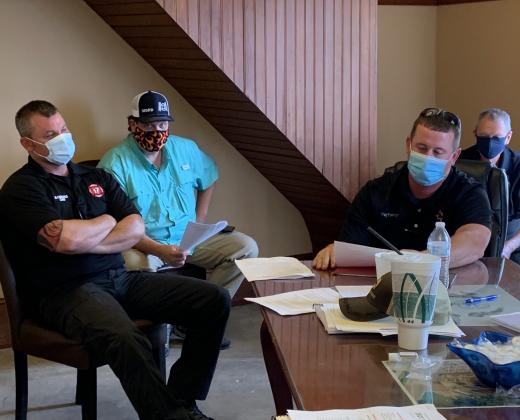Judges, commissioners don't see taxing as option
A group of county volunteer fire chiefs met with county commissioners and county judge on Tuesday afternoon to discuss what they felt were funding deficiencies rural fire stations face.
Convening at 1:30 p.m. in the county courthouse, the commissioners and judge were joined by Trey Thompson of Pickton-Pine Forest, Andy Lowen of Como, Bobby Harris of North Hopkins, Brian Fairchild of Arbala and Ray Sparks of Miller Grove.
Also present was county auditor Shannah Aulsbrook and Hopkins County Station 20 Chief and emergency management coordinator Andy Endsley.
Thompson expressed consternation that Pickton-Pine Forest, along with other county VFDs, did not have functional air cylinders, which allow firefighters to breathe when fighting a fire.
Thompson first expressed to Endlsey and the commissioners that VFDs were without this equipment at a chief’s meeting in January 2020, stating that being without the supplies was “fatally dangerous.”
“I am completely out of bottles [air canisters],” Thompson told the commissioners and Endlsey in July. “They expired in February and I went into 2020 with no bottles.”
North Hopkins’ Harris agreed, stating he recently had to instruct his crew to throw expired air canisters “right into the garbage.”
Thompson also expressed that other VFD equipment was out of date, including tires, personal protective gear, stipends for equipment repair, insurance, test pumps and chassis for fire trucks.
About expired personal protective gear, Thompson stated he would “still wear it to fight fire,” however, he stated, “If something was to happen to me, insurance wouldn’t give my family anything.”
In all, Thompson detailed approximately $76,000 worth of supplies and updates he believed VFDs needed in order to operate effectively and be under compliance with the National Fire Protection Association law.
This projected cost by Thompson did not include monthly sums for insurance or equipment maintenance that VFDs currently do not receive.
As of Oct. 1, 2019, VFDs are given an average of $700 per month from the county in addition to fuel reimbursement, although this amount varies per VFD based on a specific mathematical formula.
“Nobody knows this formula,” Thompson claimed. “It’s evident.”
Judge Robert Newsom, however, is unsure where this additional money for VFDs would come from.
“If you can figure out a new stipend that’s more realistic, I agree, it’s not realistic right now,” Newsom said. But, said Newsom, “We only have so much money we can spend… and we cannot raise taxes.”
“We don’t have the cash to just go buy everything,” Newsom said. “It’s a little exasperating… It’s a lot of money and we have to budget it.”
A survey by the News-Telegram found that 27% of respondents were in favor of creating an ESD, and 28% wanted Hopkins County to give VFDs more funding. Thirty-three percent were in favor of more aggressive fundraising by VFDs, and 1% said VFDs should make due with what they have. Ten percent said VFDs should be funded by a combination of all of these approaches.
Of concern to Pct. 1 Commissioner Mickey Barker, he said, was that the VFD chiefs did not appear as one united voice.
“How can Precinct 1 and 2 dictate what the others do?” Barker asked. “If y’all aren’t all eleven together, it splits us.”
The division among the chiefs, according to Sparks, was due to the idea of emergency service districts (ESD). An ESD allows a volunteer fire department to add an ad valorem property tax for county citizens to fund emergency services such as volunteer fire departments.
“The ones on the south side [Miller Grove, Brinker, Arbala, Pickton-Pine Forest] have run the numbers on an ESD and saw where it could be a very good benefit for the fire service," Thompson said.
"The ones on the north side… I feel, are not knowledgeable about it. It’s always been that ESDs are bad.”
Barker pointed out that in general, raising taxes is viewed as bad.
“The way I look at it, y’all are volunteer fire departments,” said Pct. 3 Commissioner Wade Bartley. “Now you’re coming to tax people, you want to get paid for it.”
Thompson pointed out that volunteers would still donate their time, and that an ESD would pay for equipment and insurance.
“When you start taking people’s money, you’re held to a higher standard,” Barker added.
“I don’t doubt y’alls effort and time, but let’s look at if they [VFDs] are making enough to stay afloat,” Thompson said. “Otherwise I don’t know what we’re going to do. One day it’ll be one guy and his truck out there fighting fire, and that’s not what any of us want.”


